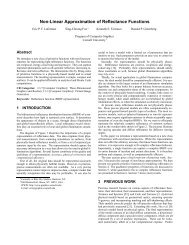pigmented colorants: dependence on media and time - Cornell ...
pigmented colorants: dependence on media and time - Cornell ...
pigmented colorants: dependence on media and time - Cornell ...
Create successful ePaper yourself
Turn your PDF publications into a flip-book with our unique Google optimized e-Paper software.
example shown in Figure 3.28. Under c<strong>on</strong>stant stimulati<strong>on</strong>, the opp<strong>on</strong>ent nature<br />
of gangli<strong>on</strong> receptor fields will produce a weakened resp<strong>on</strong>se. The off-regi<strong>on</strong>s of<br />
the cells are inhibiting the resp<strong>on</strong>se <strong>and</strong> we perceive the stimulus as being darker<br />
than it actually is. As we move closer to the edge, more off-regi<strong>on</strong> porti<strong>on</strong>s of<br />
receptor fields are receiving less light. Therefore more off-regi<strong>on</strong> receptor fields<br />
are receiving their desired resp<strong>on</strong>se, while the <strong>on</strong>-receptors are still receiving their<br />
desired bright resp<strong>on</strong>se. Hence, the total amount of excitati<strong>on</strong> is increasing as we<br />
move toward the edge. The maximum resp<strong>on</strong>se is right at the edge of the light <strong>and</strong><br />
dark regi<strong>on</strong>s. The result is that we perceive the light area getting slightly brighter<br />
close to the edge. A similar effect occurs for the dark area, as it is perceived as<br />
slightly darker near the edge.<br />
Ratliff was the first to physically measure these differences in intensity <strong>and</strong><br />
perceived brightness. He measured the nerve impulses produced by steady il-<br />
luminati<strong>on</strong> of a single receptor in the eye of the horseshoe crab Limulus. The<br />
nerve fibers from the receptor are separated by microdissecti<strong>on</strong> <strong>and</strong> c<strong>on</strong>nected to<br />
an electrode from an amplifier <strong>and</strong> a recorder. However, Ernst Mach explored the<br />
c<strong>on</strong>necti<strong>on</strong> between reflected light intensity <strong>and</strong> the resulting sensati<strong>on</strong> beforeh<strong>and</strong>.<br />
He hypothesized the antag<strong>on</strong>istic influences in the retina, as his experiments with<br />
intensity <strong>and</strong> percepti<strong>on</strong> of light did not corresp<strong>on</strong>d. The pattern in Figure 3.30 is<br />
similar to <strong>on</strong>e of which Mach developed. The apparent lightness within each bar<br />
varies even though the intensity of light reflected is c<strong>on</strong>stant. Most people describe<br />
the edges of each bar having slight b<strong>and</strong>s. Hence the term Mach b<strong>and</strong>s, which are<br />
the illusi<strong>on</strong>ary spatial gradati<strong>on</strong>s in perceived lightness that occurs without corre-<br />
sp<strong>on</strong>ding gradati<strong>on</strong>s in the actual distributi<strong>on</strong> of light.<br />
Mach b<strong>and</strong>s emphasize the important distincti<strong>on</strong> between intensity <strong>and</strong> light-<br />
88



